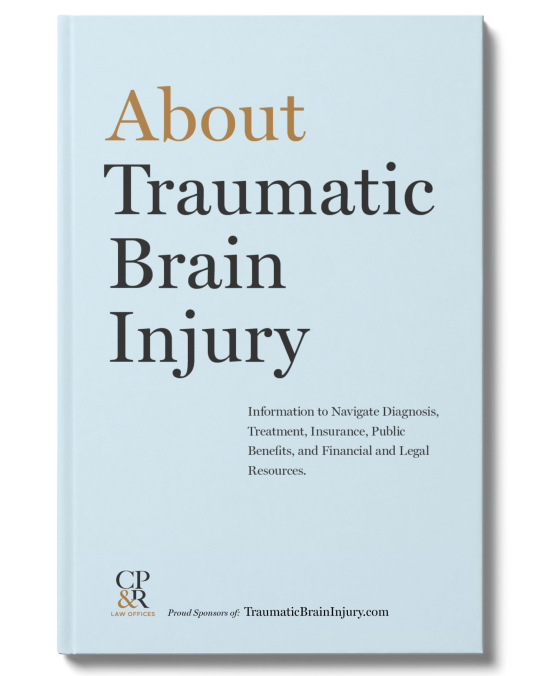Educational Benefits Beyond Early Intervention for Children With Traumatic Brain Injuries
A primer on preschool and school-age services that are available for assistance
Request our Free Book on Traumatic Brain Injury

IDEA is a federal law that provides students with disabilities with a free, appropriate, and public education that meets their unique needs. The goal of IDEA is to promote inclusion and accessibility by providing children with disabilities with the same opportunities for education as their peers. The law requires the development of an Individualized Education Planner (IEP) for each eligible student, and an IEP outlines specific individual educational goals, services, and accommodations.
IDEA supports early intervention (EI) services for infants and toddlers as well as educational resources beyond EI.
Need to learn more about navigating TBI care and assistance for your child?

Preschool Services
Preschool programs are available for 3 to 5 year-old children with developmental delays or disabilities and the goal of these programs are to build on the gains established during EI services for younger children. These programs include a range of educational, therapeutic, social services, and specialized instruction tailored to the child’s unique needs. These programs promote social interactions with other children. Activities may include speech and language therapy, PT, OT, and developmental play, all focused on the essential skills needed to be ready for school and social and emotional development.
The transition from EI services to special educational benefits begins with understanding the concept of an IEP, which is the centerpiece for services for children diagnosed with developmental delays or disabilities. The service coordinators who are available in the birth to age three programs are often not available for children aged three to five, and the families need to prepare to assume a greater role in advocacy during this crucial time.
Transition to School-Age Services
Typically, the same principles apply to children over 5 years old with disabilities that apply to preschoolers. As children diagnosed with developmental delays and disabilities approach their third birthday, a formal transition process is necessary to prepare for the move to school-age special education services. The transition will continue through age 5 and it again involves multidisciplinary comprehensive evaluations, like the evaluation performed during the assessment for early intervention. New assessments determine the child’s needs and eligibility for an IEP.
An IEP is an academic-focused and tailored plan that identifies the unique learning needs of each child as they enter preschool or kindergarten. The IEP focuses on the child’s individualized educational goals and the specific services required. The goal is to develop a plan to help each child achieve success within a school setting. Re-evaluations occur each year for children aged three to five because the needs of children change as they develop. A written evaluation will be prepared and provided to the school district as well as the child’s parents or guardians.
An important feature in this transition from early intervention to school-age services is multidisciplinary team meetings, which involve parents, educators, and specialists. During these meetings, the team collaboratively assesses the child’s preparedness for school and set goals that reflect both their educational skills/needs as well as their social/emotional development. The goal is to maintain continuity of care and provide needed support as children transition from early intervention to special education. The collaboration among families, educators, and service providers during this transition is critical to support the evolving needs of the child.
That said, if the parents or guardians feel that the school is not effectively collaborating or addressing the needs of their child, they should contact an independent advocate or education lawyer.
School-Age Services: IDEA and Section 504 of the Rehabilitation Act of 1973
The primary goal of IDEA is to provide equal access to education for school-age children with developmental delays or disabilities through the provision of a free appropriate public education (FAPE) tailored to a child’s individual needs. That said, Section 504 of the Rehabilitation Act of 1973 (504 Plan) provides further resources for educational support, beyond IDEA. A 504 Plan is designed to accommodate students who have a disability that substantially limits one or more major life activities, including learning, but who may not qualify for an IEP under IDEA. A 504 Plan can include modifications and accommodations to the learning environment, such as access to assistive technology, additional testing time, and preferred seating arrangements.
An IEP is for children with certain defined disabilities, and it provides comprehensive services, including specialized instruction. A 504 Plan is different. It supports a broad range of students with varying needs without requiring a specialized education setting and emphasizes accommodations and modifications, such as a wheelchair ramp, highlighted textbooks, extended time for tests and assignments, assistance with note taking, extra sets of textbooks for home use, computer-aided instruction, large print books and visual aids, behavioral intervention, taped lectures, and oral testing.
The goal of these combined programs is to provide education and resources needed for all students to succeed. Schools have a legal obligation to respect the rights of children under both IDEA and Section 504 and establish an environment where all students can learn and grow at their own pace.
IEP Evaluations
Planning for the need for IEP can begin as early as birth or during the toddler years, long before the actual IEP evaluation process begins. Not all school districts are created equally and have the same resources and capacity to accommodate children’s special needs. Parents and caretakers of eligible children need to learn about the quality and availability of local school district resources. In cases of CP and moderate to severe TBI, parents and caretakers should focus on the services available in their community and surrounding area as soon as possible.
A typical route toward IEP planning begins when a parent, teacher, or other concerned individual suspects that a child may have a developmental delay or disability. This may lead to a referral for further evaluation. Under IDEA these assessments are conducted within a certain time limit to ensure that the child receives the necessary services.
The IEP evaluation involves a comprehensive assessment of the child’s cognitive, academic, social, emotional, and behavioral functioning. The evaluation determines eligibility for special education services and in the development of an individualized education plan.
This evaluation typically includes an assessment of the child’s present academic achievement levels and functional performance, as well as an evaluation of the child’s strengths and challenges. Functional performance evaluates how a disability may interfere with a child’s ability to progress and be involved in the school curriculum. It also identifies appropriate goals and objectives given the child’s needs. The IEP must also consider the required special education services, including necessary accommodation and modifications needed to support the child’s learning.
Additionally, an IEP report should include the evaluation and assessments conducted by the educational team. It must specify the methods and criteria the school district intends to use to measure progress. It addresses nuts and bolts details, such as frequency, location, and duration of services provided as well as any necessary transition services (for example, classroom transitions).
Qualifying categories of impairment for special education services are broad and encompass various physical, emotional, and mental conditions. These include CP, brain injury, autism spectrum disorder, intellectual disability, specific learning disabilities, emotional disturbance, sensory impairments (such as deafness or blindness), and orthopedic impairments, among others. Each category has specific criteria that are defined in federal and state regulations.
In situations where parents or guardians believe that the school district’s evaluation was insufficient or did not accurately reflect their child’s needs, they have legal rights. Under IDEA parents of a child with a disability have the right to: 1) obtain “an independent educational evaluation [IEE] of the child”; and 2) have the evaluation conducted by a qualified evaluator who is not employed or associated with the school system. The purpose of the IEE is to provide an objective evaluation by a third party. This process is essential because it allows parents to get an independent opinion, if there is a disagreement with the public school system, regarding the child’s needs.
“Related Services” and Nursing Care in Schools
Other special education services that assist special needs children are known as related services. Public school systems provide the related services at no cost to the parents. These services include transportation to and from school, specialized equipment (wheelchairs, lifts, adapted devices, and ramps), developmental, corrective, and supportive services, speech and language pathology, audiology, psychological services, PT, OT, recreational therapy, and school health services. Importantly, the school district must fund skilled nursing and attendant care. In 1999, the United States Supreme Court ruled that among the related services required under IDEA, public schools must fund required “continuous, one-on-one nursing care for disabled children,” despite arguments from the school district concerning the costs of those services.
Special Education Due Process Procedures
There are due process procedures in place to ensure that children’s rights to special educational services are protected. In other words, any denial of necessary benefits and services by the school system is not the last word — there is a review and hearing process.
These procedures provide parents and guardians with methods for resolving disputes with school districts regarding the identification, evaluation, placement, or provision of FAPE for their children. The process begins with a prehearing conference, which is a voluntary meeting where both parties (parents and school representatives) meet to discuss and attempt to resolve conflicts before they escalate to hearings. The parties have an opportunity to speak, clarify misunderstandings, and attempt resolution. That said, before appearing for a prehearing conference, parents must have information about their rights and the school district’s responsibilities to ensure that they get the best possible result for their child. Without that information, parents cannot negotiate on an even playing field with the school district.
If the prehearing conference does not resolve the dispute, parents may request and schedule a formal hearing (called a due process hearing). An impartial hearing officer conducts this hearing. Both parties present evidence, call witnesses, and provide arguments supporting their positions regarding the contested matters of the child’s special education services. The hearing officer reviews the information presented and issues a legally binding decision to resolve the dispute. The outcome purpose of this law is to ensure that the school system is attending to the educational needs of the child in accordance with federal and state laws governing special education.
If either party disagrees with the decision made during the hearing, they have the right to appeal the decision. Parents or guardians can seek a review of the hearing officer’s ruling through higher administrative channels or the courts. It is important for parents to understand their rights throughout this process because it can be complex and may require legal representation. There are lawyers who specialize in education law.
Parents and guardians must also keep in mind that until the parties resolved their dispute, the child’s public-school program remains as it was before the determination of the IEP or the proposed IEP change. Unfortunately, this process takes time. It is therefore important for parents and guardians to be prepared to present all evidence as early in the process as possible — preferably at the prehearing conference — so that the best efforts can be made to resolve issues promptly. Evidence should include all documentation, reports, medical records, and test results needed to support the IEP or the requested revisions to the IEP.
FAQs About Educational Benefits for Children with Traumatic Brain Injury
No. Educational services provided by a school district must be free to all individuals who qualify for special education and benefits. In addition, it is necessary to place a child in a private school, the public school system may have to pay some or all the cost (depending upon circumstances).
Yes. An IEP is a legally enforceable contract by the school district. If the school district fails to comply with all the provisions of the IEP, the families can seek to enforce full compliance.
No. If there is evidence to support the need for changes in the IEP, a family can request a new or modified IEP at any time.
Yes. A school district must pay for required related services and benefits (including assistive technology) to assist a child with disabilities even when a child is being home schooled.
Yes. Special education plans can provide extended education benefits during weekends, the summer months, or both. A school district by law may be required to provide an extended school year to comply with the plan, beyond the typical 180-day school year. However, the family must be able to prove the importance of the extended school year. For example, if the reason for the additional school is regression, the family will have to prove why regression will occur if there is a break in the educational program. This may require experts and other documentation.
No. Special educational benefits may continue through age 21. However, benefits will not continue if the child graduates at age 18. If a child still needs special educational benefits at age 18, the parents should not allow the child to graduate at age 18.
To learn more about services and support for children with TBI — including your legal rights — read the article What Is Traumatic Brain Injury?
Need help investigating your legal rights related to a traumatic brain injury?
Speak to an experienced brain injury attorney team like Cohen, Placitella & Roth.
For five decades, CPR has successfully represented individuals and families in TBI cases nationwide working with qualified co-counsel.


Get Our Free Traumatic Brain Injury Book
To learn more about Traumatic Brain Injury request our comprehensive book, available for free directly to your inbox



